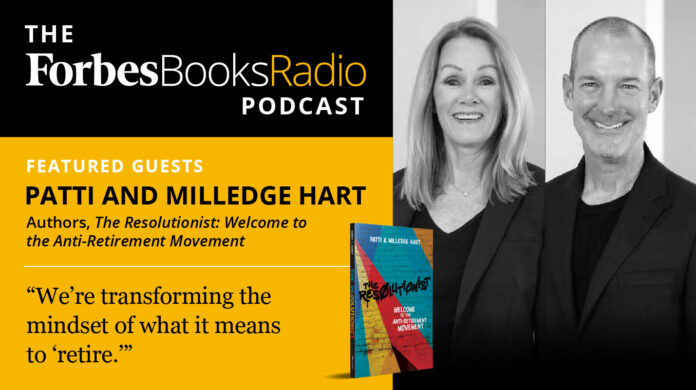Singer Jim Croce longed to put time in a bottle.
Retirees aren’t always certain what it is they long to do with time, but one day they stop working and find they have a barrelful of it.
“People often are so focused on making sure they are financially ready to retire that they forget to plan for what they want to do in retirement,” says Patti Hart, co-author with her husband, Milledge, of The Resolutionist: Welcome to the Anti-Retirement Movement.
“And they may have more time to fill than they realize. Life expectancy has grown, and retirements that last 20 years, 30 years, or longer aren’t that unusual. So you have to start thinking, what will you do with your time? How do you envision your days playing out?”
For the Harts, the answers to those questions involve the “anti-retirement movement,” where retirement is more than a rocking chair on a front porch or endless hours of golf.
“We did leave our careers, but we would never call ourselves retired,” Milledge Hart says. “We are busier now than we’ve ever been. The difference is that we are busy doing what brings us joy rather than what advances our careers.”
But the transition isn’t always easy, which is why the Harts recommend finding efficient ways to manage that extra time the post-career years bring.
Patti Hart cautions that time management does not have to mean blocking out every minute.
“For most people, it is just setting goals and priorities, then making sure you plan for how you are going to accomplish them,” she says. “It is being productive with your time.”
To do that, the Harts suggest putting yourself into the mindset you had in your working years, such as:
-
Use a calendar. People in a corporate setting rely on calendars to manage their obligations and retirees can as well. “Too often people just think they will remember that they have yoga on Tuesday and Thursday, and volunteer at the animal shelter on Wednesday,” Patti Hart says. “But then they add a lunch here or a board meeting there and pretty soon find themselves scurrying from activity to activity.” Checking a calendar each day also let’s people know they may need to pull back if they are overcommitted, or they may need to find activities to add if too many empty hours are going to waste.
-
Make a to-do list. A to-do list helps ensure nothing gets forgotten. Just be flexible, Milledge Hart says, because the list is a tool to keep you on track, not a ball and chain to imprison you. “If you’d rather do something else today, feel free to move items to another time or just skip them altogether,” he says. “It’s your list so it’s your call.”
-
Treat everything like a business appointment. The calendar and the to-do list can be filled with things that would never have made a business person’s schedule – but may now be high priority for you. “You can pencil in 30 minutes for meditation or an hour to begin reading a James Patterson novel,” Patti Hart says. “Maybe you want to block out Friday afternoon to experiment with a new recipe. These are your preferred ‘appointments’ now and are equal in importance to board meetings or conference calls.”
-
Adapt your system as your needs change. Some people begin retirement doing all the things they had been putting off, such as traveling or fishing more. “But that first burst of activity usually begins to wear, and you realize you want more from this stage of life,” Milledge Hart says. “At that point it makes sense to reevaluate your resources and goals. Be aware of how you feel about certain activities and be ready to drop some and pick up others as your time and interests change.”
“In the same way that making good financial investments provides you with additional capital, investing your time wisely provides you with more time to do things you really want to do,” Patti Hart says. “ And that will make your life so much better.”
Patti and Milledge Hart, co-authors of The Resolutionist: Welcome to the Anti-Retirement Movement, spent more than 30 years as executive leaders in numerous technology and investment banking businesses. Today, in what they refer to as the “Resolutionist” – rather than retirement – phase of their lives, they are applying their resources and skills in new ways to advance philanthropic and corporate activities around the globe.


